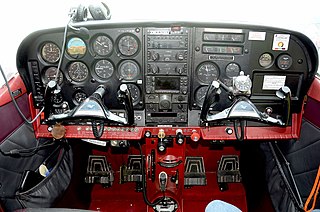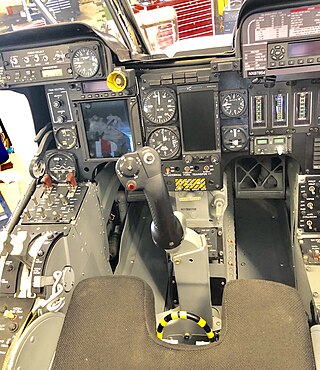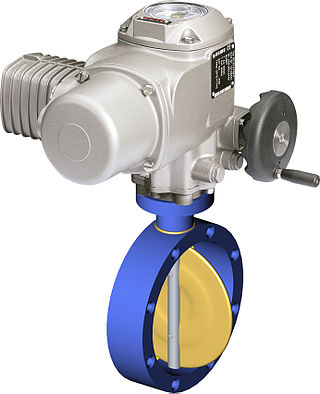Related Research Articles

Fly-by-wire (FBW) is a system that replaces the conventional manual flight controls of an aircraft with an electronic interface. The movements of flight controls are converted to electronic signals transmitted by wires, and flight control computers determine how to move the actuators at each control surface to provide the ordered response. It can use mechanical flight control backup systems or use fully fly-by-wire controls.

Pneumatics is a branch of engineering that makes use of gas or pressurized air.

A hydraulic fluid or hydraulic liquid is the medium by which power is transferred in hydraulic machinery. Common hydraulic fluids are based on mineral oil or water. Examples of equipment that might use hydraulic fluids are excavators and backhoes, hydraulic brakes, power steering systems, automatic transmissions, garbage trucks, aircraft flight control systems, lifts, and industrial machinery.
An actuator is a component of a machine that is responsible for moving and controlling a mechanism or system, for example by opening a valve. In simple terms, it is a "mover".

Aircraft engine controls provide a means for the pilot to control and monitor the operation of the aircraft's powerplant. This article describes controls used with a basic internal-combustion engine driving a propeller. Some optional or more advanced configurations are described at the end of the article. Jet turbine engines use different operating principles and have their own sets of controls and sensors.

Fluid power is the use of fluids under pressure to generate, control, and transmit power. Fluid power is conventionally subdivided into hydraulics and pneumatics. Although steam is also a fluid, steam power is usually classified separately from fluid power. Compressed-air and water-pressure systems were once used to transmit power from a central source to industrial users over extended geographic areas; fluid power systems today are usually within a single building or mobile machine.

A conventional fixed-wing aircraft flight control system (AFCS) consists of flight control surfaces, the respective cockpit controls, connecting linkages, and the necessary operating mechanisms to control an aircraft's direction in flight. Aircraft engine controls are also considered as flight controls as they change speed.

Hydraulic machines use liquid fluid power to perform work. Heavy construction vehicles are a common example. In this type of machine, hydraulic fluid is pumped to various hydraulic motors and hydraulic cylinders throughout the machine and becomes pressurized according to the resistance present. The fluid is controlled directly or automatically by control valves and distributed through hoses, tubes, or pipes.

Drive by wire or DbW technology in the automotive industry is the use of electronic or electro-mechanical systems in place of mechanical linkages that control driving functions. The concept is similar to fly-by-wire in the aviation industry. Drive-by-wire may refer to just the propulsion of the vehicle through electronic throttle control, or it may refer to electronic control over propulsion as well as steering and braking, which separately are known as steer by wire and brake by wire, along with electronic control over other vehicle driving functions.
Power steering is a system for reducing a driver's effort to turn a steering wheel of a motor vehicle, by using a power source to assist steering.

A linear actuator is an actuator that creates motion in a straight line, in contrast to the circular motion of a conventional electric motor. Linear actuators are used in machine tools and industrial machinery, in computer peripherals such as disk drives and printers, in valves and dampers, and in many other places where linear motion is required. Hydraulic or pneumatic cylinders inherently produce linear motion. Many other mechanisms are used to generate linear motion from a rotating motor.

The Learjet 25 is an American ten-seat, twin-engine, high-speed business jet aircraft manufactured by Learjet. It is a stretched version of the Learjet 24.

A hydraulic motor is a mechanical actuator that converts hydraulic pressure and flow into torque and angular displacement (rotation). The hydraulic motor is the rotary counterpart of the hydraulic cylinder as a linear actuator. Most broadly, the category of devices called hydraulic motors has sometimes included those that run on hydropower but in today's terminology the name usually refers more specifically to motors that use hydraulic fluid as part of closed hydraulic circuits in modern hydraulic machinery.

Brake-by-wire technology in the automotive industry is the ability to control brakes through electronic means, without a mechanical connection that transfers force to the physical braking system from a driver input apparatus such as a pedal or lever.
In aviation, a power transfer unit (PTU) is a device that transfers hydraulic power from one of an aircraft's hydraulic systems to another in the event that the other system has failed or been turned off.
An electrohydraulic servo valve (EHSV) is an electrically-operated valve that controls how hydraulic fluid is sent to an actuator. Servo valves are often used to control powerful hydraulic cylinders with a very small electrical signal. Servo valves can provide precise control of position, velocity, pressure, and force with good post-movement damping characteristics.

Aircraft systems are those required to operate an aircraft efficiently and safely. Their complexity varies with the type of aircraft.

This article briefly describes the components and systems found in jet engines.

A rotary actuator is an actuator that produces a rotary motion or torque.

A booster pump is a machine which will increase the pressure of a fluid. They may be used with liquids or gases, but the construction details will vary depending on the fluid. A gas booster is similar to a gas compressor, but generally a simpler mechanism which often has only a single stage of compression, and is used to increase pressure of a gas already above ambient pressure. Two-stage boosters are also made. Boosters may be used for increasing gas pressure, transferring high pressure gas, charging gas cylinders and scavenging.
References
Notes
- ↑ "FTE New Electro-Hydraulic Clutch Actuator for Automated Manual Transmissions". Archived from the original on 2021-06-02.
- ↑ "Lockheed P-38 Lightning Pilot's Flight Manual", pg. 5
- ↑ Frischemeir, pg. 2
- ↑ Maré, Jean-Charles (10 September 2021). Uchino, Kenji (ed.). "Review and Analysis of the Reasons Delaying the Entry into Service of Power-by-Wire Actuators for High-Power Safety-Critical Applications" (PDF). Actuators. 10 (9): 233. doi: 10.3390/act10090233 . Retrieved 11 November 2022.
- ↑ "Hydraulics".
- ↑ "Vickers Armstrong (Aircraft) LTD: VC 10; powered flight control units by Boulton Paul".
- ↑ Frischemeir, pg. 3 [ failed verification ]
- ↑ C. W. Helsley, Jr., "Power By Wire for Aircraft - the All-Electric Airplane", SAE, #771006, February 1977
- ↑ Adams
Bibliography
- Robert Navarro, "Performance of an Electro-Hydrostatic Actuator on the F-18 Systems Research Aircraft", NANASA/TM-97-206224, October 1997
- Stefan Frischemeir, "Electrohydrostatic Actuators for Aircraft Primary Flight Control", Technical University Hamburg-Harburg
- Charlotte Adams, "A380: 'More Electric' Aircraft", Avionics, 1 October 2001